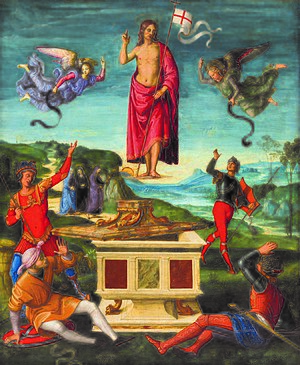| The Resurrection of Christ (Kinnaird Resurrection) (Photo credit: Wikipedia) |
Solemnity
of the Christian Church in commemoration of the resurrection of Jesus
Christ is celebrated the first Sunday after the first full moon
following the vernal equinox, the applicant between March 22 and April
25, initially was celebrated every Sunday, the anniversary should be at
the Council of Nicaea in the second century AD, which also established
to set this party on the first Sunday after the first full moon after
the vernal equinox.
For
Christianity is the first and fundamental feast of the liturgical year,
for Christ is the "transition" from earthly life, through suffering,
the eternal life for Christians is the "transition" from sin to new life
in Christ, through baptism.
The
Easter celebrations that have their culmination in the Paschal Triduum
on Thursday, Friday and Holy Saturday, and especially in the Easter
Vigil and Easter Day, are prepared from Lent.
The joy of Easter continues for seven weeks, "as a day of celebration and joy" and ends with Pentecost.
The
mathematical calculation of the date is very complex and difficult
because you should know: the letter Sunday, the epact (the age of the
moon on the 1st January of the year you want to calculate) the Roman
indiction, the solar cycle, the number aureus (position within the loop
of the methodical latter meaning a period of 19 years by superimposing
the solar cycle).
The
complexity of these calculations can be overcome by a simple formula
due to the mathematician, astronomer, physicist and surveyor German Karl
Friedrich Gauss, which is still used:
Let A be the year for which you want to calculate Easter, M and N are the values referred to below should indicate multiplication table and the remains of the following divisions:
A: 19 with "a"
A: 4 with "b"
A: 7 with "c"
(19 x "to" M +): 30 with "d"
(2 x "b" + 4 x "C" +6 x "d" + N): 7 with "and"
for the years ..... ..... N M is worth
1700-1799 ........ 23 ......... 3
1800-1899 ........ 23 ......... 4
1900-2099 ........ 24 ......... 5
2100-2199 ........ 24 ......... 6
Then
Easter will fall on the day (22 + "d" + "and") in March, or, if the
resulting figure exceeds 31, the date ("d" + "and" - 9) in April, where
22:09 is two fixed numbers.
In
the rich theme of Easter customs appears the tradition of eating the
lamb, the Jewish Passover meal recalls the memory of the exodus from
Egypt by the "passing" of the Red Sea, the "step" that is, freedom from
slavery in Egypt ; to celebrate the renewal Moses commanded the people
to sacrifice a lamb, all white, tingerne the doors with the blood, roast
it and eat it with unleavened bread, on the evening of the fourteenth
day of the first month of spring, for the Jews, then eat the 'Lamb
recalls the sacrifice offered to the God of Israel before leaving Egypt,
for a Christian is "the Lamb of God," the lamb of Christ, the innocent
victim and immaculate.
The
eggs blessed reminder that in times past were forbidden during Lent and
then reappear on the table along with the kid, lamb, salami with the
meaning that the time of penance and fasting was over, were brought to
be blessed before being donated as a symbol of hope, abundance and new
life.
Around
the fifteenth century were served for lunch boiled eggs painted by hand
and spread in many European countries the tradition of starting
breakfast with an omelette made with eggs laid by hens on Good Friday.
In
the sixteenth century began the custom of hiding the eggs with a
surprise and the importation of cocoa from Mexico entered the surprise
egg chocolate.
The
tradition of Easter dove, which is the symbol of the Holy Spirit,
should not appear on the table at Easter, Pentecost, but because it
wants to commemorate the peace between God and men returned after the
flood, in fact it was a dove to return Ark with an olive branch in its
beak.
A
popular tradition of the evening of Holy Saturday is the one that is
still followed in Florence, during the rites of the Resurrection and a
dove (now no longer alive but artificial) is started from the main altar
with a small rocket on a wire and sliding it set fire to a cart it all
meant to symbolize the purity of the soul and purifying power of fire is
always present in the ancient rites of Christianity but, very often,
replaced it with holy water


No comments:
Post a Comment